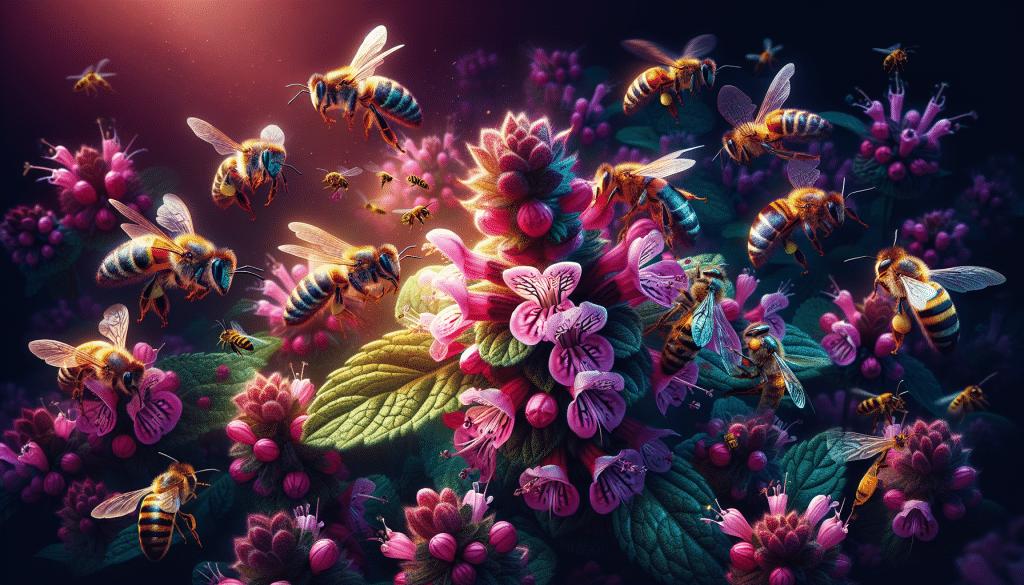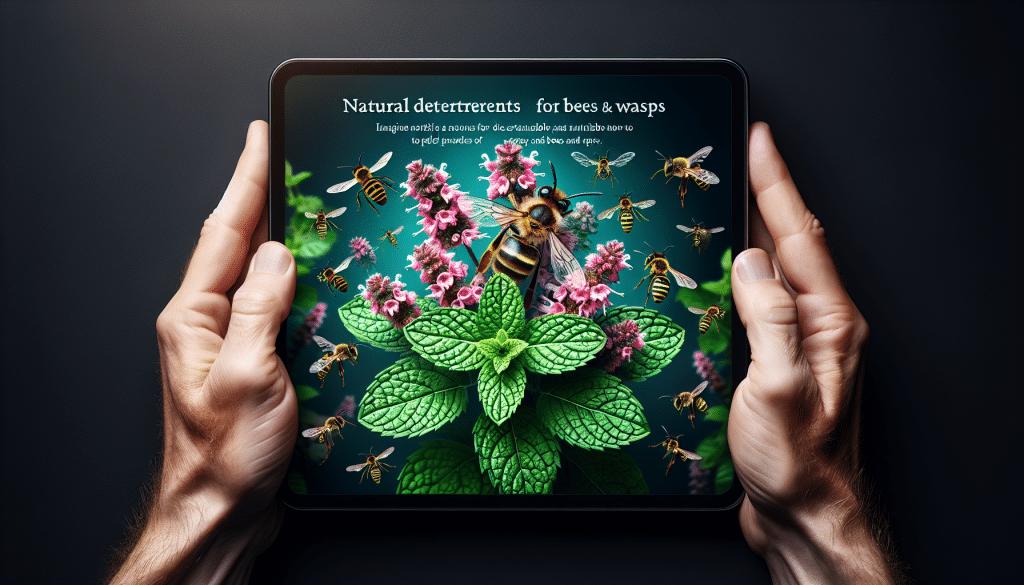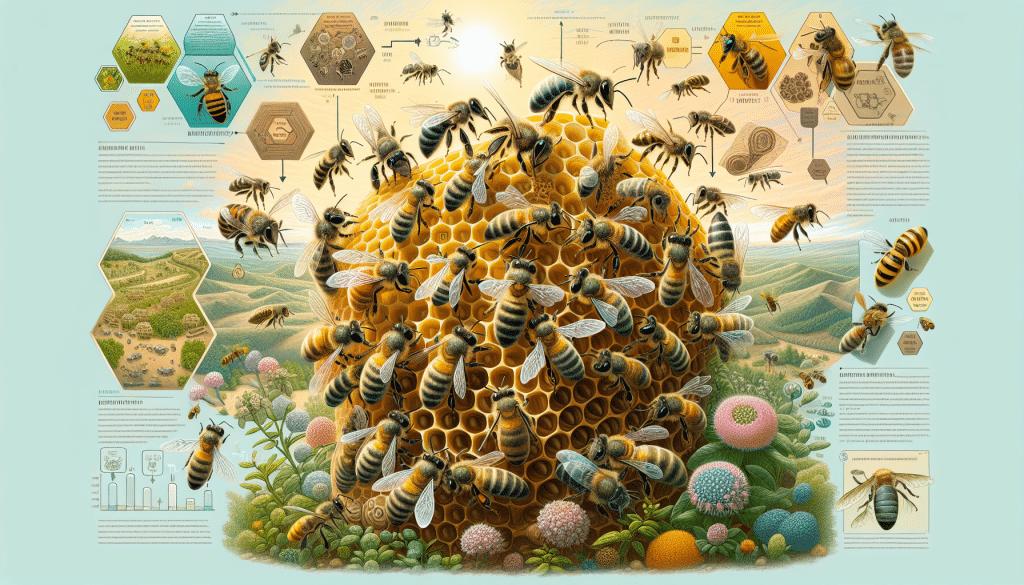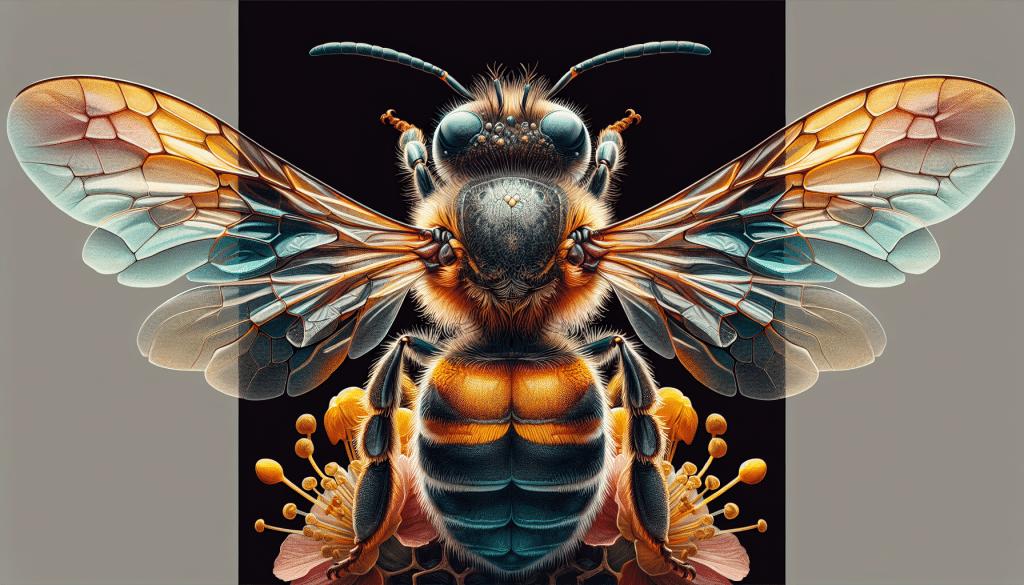Are you tired of bees and wasps buzzing around you and ruining your outdoor fun? Well, you’re in luck! In this article, you’ll discover 10 simple and natural ways to keep those pesky insects away. From planting certain herbs to using essential oils, these methods are safe for you and the environment. Say goodbye to bee and wasp encounters, and hello to a peaceful outdoor experience!

Understanding Bee and Wasp Behavior
Differences between bees and wasps
Bees and wasps may look similar, but they have some key differences. Bees are usually fuzzy and have a rounder body shape, while wasps are more slender and have smooth bodies. Bees feed on nectar and pollen from flowers, and they play a vital role in pollinating plants. Wasps, on the other hand, are predators and feed on other insects. Bees also die after stinging, while wasps can sting multiple times.
Role of bees and wasps in the ecosystem
Bees and wasps are important for our ecosystem. Bees help pollinate flowers, which allows them to reproduce and create more plants. This is crucial for growing fruits, vegetables, and nuts that we eat. Wasps, although sometimes seen as pests, help control the population of other insects by hunting and eating them. Without bees and wasps, our world would be a very different place!
Reasons bees and wasps might be attracted to your home
Bees and wasps might be attracted to your home for a few reasons. They are often attracted to sweet-smelling flowers, ripe fruits, and sugary drinks. They are also attracted to areas where food is left out or garbage bins that are not properly sealed. Additionally, bees might make their nests in cozy spots like tree branches or the eaves of houses, while wasps might build their nests in the ground or under house eaves. It’s important to understand these attractions to better prevent them from coming near your home.
Use of Natural Repellents
Benefits of using natural deterrents
Natural repellents are a great way to keep bees and wasps away without harming them or the environment. Unlike chemical repellents, natural deterrents do not contain harmful toxins or pose a risk to pets or humans. They are also a more eco-friendly option because they do not harm beneficial insects like bees. By using natural repellents, we can create a safe and healthy environment for everyone.
Common ingredients in natural repellents
Natural repellents often use ingredients that bees and wasps find unpleasant or overwhelming. Some common ingredients include essential oils like citronella, peppermint, and eucalyptus. These oils have strong scents that bees and wasps dislike. Vinegar, garlic, and certain herbs like mint and lemongrass are also effective in deterring these insects. Using these simple and natural ingredients, you can create your homemade repellents.
Safety considerations when using natural repellents
While natural repellents are generally safe, it’s important to follow some safety considerations. Essential oils should always be diluted with a carrier oil before applying them to the skin, as they can cause irritation in their concentrated form. It’s also important to avoid using these repellents near open flames or heat sources to prevent fires. Always read and follow the instructions for each repellent to ensure safe and effective use.

Planting Repellent Flora
Types of plants that repel bees and wasps
Did you know that certain plants can naturally repel bees and wasps? Some plants have strong scents or produce chemicals that these insects find unpleasant. Examples of plants that repel bees and wasps include marigolds, peppermint, eucalyptus, basil, lavender, and citronella grass. By incorporating these plants in your yard or garden, you can help deter bees and wasps from making nests nearby.
How to strategically plant these flora in your yard or garden
To strategically plant these flora, it’s important to place them in areas where bees and wasps are most likely to be attracted. Surrounding your outdoor dining area or picnic spot with these plants can help create a natural barrier. Placing them near windows or entrances to your home can also discourage bees and wasps from entering. Be sure to give each plant enough space to grow and thrive, and consider their sunlight and water requirements.
Caring for these plants
To care for these plants, make sure to provide them with enough sunlight, water, and the right type of soil. Each type of plant may have different care requirements, so gather information about specific plant needs. Regularly remove any weeds or dead plant material that can attract bees and wasps. By maintaining healthy plants, you create a less favorable environment for these insects to settle in.
Homemade Bee and Wasp Repellents
Recipes for homemade repellents
Making your own bee and wasp repellents is easy and fun! Here are a few simple recipes you can try:
- Lemon and Cloves Spray: Boil water and add the juice of 2 lemons and a handful of cloves. Let it cool, strain the liquid, and pour it into a spray bottle. Spray it around areas you want to keep bees and wasps away from.
- Vinegar and Water Solution: Mix equal parts white vinegar and water in a spray bottle. Spray this solution near doors, windows, and other entry points to deter bees and wasps.
- Peppermint Oil and Water Spray: Mix 10 drops of peppermint essential oil with a cup of water. Shake well and spray it around areas where bees and wasps are commonly seen.
Materials needed to prepare these repellents
To prepare these homemade repellents, you will need some basic materials:
- Spray bottles: These are used to apply the repellents to the desired areas.
- Lemons, cloves, vinegar, peppermint oil: These are the main ingredients for the repellents depending on the recipe you choose.
- Water: Most repellents require water as a base ingredient to dilute other ingredients.
Make sure you have these materials ready before you start making your own repellents.
How to apply homemade repellents
Applying homemade repellents is easy. Fill a spray bottle with your chosen recipe, shake it well, and spray it around areas where bees and wasps are frequently seen or where you want to keep them away from. Remember to avoid spraying directly on bees or wasps, as this can harm them. Reapply the repellents every few days or after rain to ensure their effectiveness.

Use of Essential Oils
Types of essential oils that can repel bees and wasps
Essential oils have strong scents that can repel bees and wasps. Some popular essential oils for deterring these insects include citronella, peppermint, eucalyptus, lemongrass, and lavender. These oils can be used individually or blended together to create a customized repellent. Bees and wasps find these scents overwhelming and tend to stay away from areas where these oils are present.
Methods for using essential oils as repellents
There are several methods for using essential oils as bee and wasp repellents:
- Essential Oil Diffuser: Fill a diffuser with water and add a few drops of your chosen essential oil or blend. Place the diffuser near windows or entrances to keep bees and wasps away.
- Cotton Balls: Soak cotton balls in your desired essential oil or blend and place them in strategic areas, such as near doors, windows, or outdoor dining areas.
- Spray Bottle: Mix a few drops of essential oil with water in a spray bottle and spray it around areas that need protection from bees and wasps.
Potential health benefits of these essential oils
In addition to repelling bees and wasps, some essential oils offer potential health benefits. Peppermint oil can help relieve headaches and improve concentration. Lavender oil is known for its calming properties, which can reduce stress and promote better sleep. Eucalyptus oil may help with respiratory issues and congestion. While enjoying the benefits of these oils, it’s important to remember that proper usage and dilution are necessary to avoid any adverse reactions.
Maintaining a Clean Outdoor Space
How clutter or food waste can attract bees and wasps
Bees and wasps are attracted to clutter and food waste because they are searching for sources of food. Cluttered yards or outdoor spaces provide hiding spots for insects, such as cavities in old furniture or piles of leaves. Food waste, like uncovered trashcans or leftover picnic food, release scents that bees and wasps find irresistible. It’s important to keep your outdoor space tidy and dispose of food waste properly to reduce the chances of attracting these insects.
Tips for proper outdoor maintenance
Here are some simple tips to help you maintain a clean outdoor space:
- Regular Cleaning: Sweep away fallen leaves, clean up any spills or messes promptly, and dispose of food waste in sealed containers.
- Trimming Vegetation: Keep trees, bushes, and shrubs well-maintained and trimmed. This reduces hiding spots and also makes it easier to spot and remove any potential nests.
- Covering Trash Bins: Make sure your trash bins have tightly closed lids to prevent bees and wasps from accessing them. Also, regularly clean the bins to remove any food residue or odors.
Benefits of maintaining a clean yard or outdoor space
Maintaining a clean yard or outdoor space offers many benefits. It helps create a healthier and safer environment for you and your family. By reducing clutter and properly disposing of food waste, you minimize the risk of attracting bees and wasps. Additionally, a clean outdoor space is more enjoyable for outdoor activities like picnics, barbecues, and gardening.
Proper Food and Beverage Storage
Types of food and beverages that attract bees and wasps
Certain types of food and beverages are more likely to attract bees and wasps. Sweet foods like fruits, sugary drinks, and desserts are especially appealing to these insects. Meat and protein-based foods can also attract wasps, as they are predators and seek out other insects. It’s important to take extra care when storing and serving these items to prevent unwanted bee and wasp guests.
Safe storage methods to prevent attraction
To prevent bees and wasps from being attracted to food and beverages, follow these storage methods:
- Seal Containers: Store ripe fruits and sweet foods in sealed containers or in the refrigerator to prevent scents from attracting bees and wasps.
- Cover Drinks: When outdoors, use lids or covers for beverages to keep insects from flying into them and to prevent any spills that could attract bees and wasps.
- Clean Barbecue and Picnic Areas: Promptly clean up any food spills and residues, and keep serving areas free from leftover food to minimize bee and wasp attraction.
Keeping your picnic or BBQ bee and wasp free
To keep your picnic or BBQ bee and wasp-free, follow these additional tips:
- Set Up Away from Nests: Be aware of your surroundings and choose a picnic or BBQ spot away from known bee or wasp nests.
- Use Food Tents: If eating outdoors, consider using food tents or covers to keep insects away from your food while still allowing airflow.
- Dispose of Garbage Properly: Make sure all food waste is disposed of in sealed containers or trash bags away from your picnic or BBQ area.
Use of Decoy Nests
How decoy nests work
Decoy nests are designed to trick bees and wasps into thinking that an area is already occupied by another colony. Since bees and wasps are territorial, they typically avoid areas where other nests are established. Decoy nests resemble real nests and can deter these insects from building their nests nearby.
Where to place decoy nests
Decoy nests should be placed in areas where you want to prevent bees and wasps from building their nests. Hang them near entrances to your home, outdoor eating areas, or potential nesting sites like eaves or tree branches. The goal is to make the area seem already occupied, encouraging bees and wasps to search for a different spot.
How to make a decoy nest
Making a decoy nest is simple and can be done using materials you already have at home. Here’s how:
- Paper Bag Nest: Crumple a brown paper bag to create a nest-like shape. Hang it from a string or tree branch in the desired location.
- Mud Nest Replica: Shape modeling clay or mud into a nest-like structure. Let it dry and paint it to resemble a real bee or wasp nest. Hang it in the area where you want to deter bees and wasps.
Remember to replace or refresh the decoy nests periodically to maintain their effectiveness.
Citronella Candles and Incense
How citronella deters bees and wasps
Citronella is a plant-based oil known for its strong scent that repels many insects, including bees and wasps. When citronella candles or incense are burned, the scent is released into the air, creating a barrier that these insects find unpleasant. By using citronella candles or incense, you can create a bee and wasp-free zone for outdoor activities.
Effective use of citronella products
To effectively use citronella products, follow these tips:
- Choose Quality Products: Look for citronella candles or incense made with real citronella oil for optimal effectiveness.
- Position Candles Strategically: Place the candles or incense in areas where you want to deter bees and wasps, such as picnic tables or outdoor seating areas. Make sure they are positioned upwind to maximize the scent distribution.
- Outdoor Use Only: Citronella candles and incense are designed for outdoor use due to their strong scent. Avoid using them indoors, as they may cause irritation or be too overpowering.
Safety measures when using citronella
While citronella is generally safe, it’s important to follow these safety measures:
- Supervise Children: Keep an eye on children when using citronella candles or incense to prevent accidental burns.
- Keep Away from Flammable Materials: Make sure to place the candles or incense away from flammable objects, such as paper decorations or clothing, to avoid fire hazards.
- Extinguish Properly: Always fully extinguish citronella candles or incense before leaving the area or going to bed.
By following these safety measures, you can enjoy the benefits of citronella while minimizing any risks.
Professional Pest Control Services
When to consider professional help
If you have a severe bee or wasp infestation, or if DIY methods have not been successful in deterring these insects, it may be time to consider professional pest control services. Professional help is especially important if you or someone in your family is allergic to bee or wasp stings, as they can cause severe reactions. Don’t hesitate to seek assistance when needed, as professionals have the knowledge and tools to handle these situations safely and effectively.
What to expect from a pest control service
When you hire a pest control service, they will assess the situation and determine the best course of action. This may include identifying and eliminating existing bee or wasp nests, offering advice on prevention methods, and providing ongoing monitoring and maintenance if necessary. They will also ensure that any actions taken are safe for you, your family, and the environment.
Choosing a reliable pest control service
When choosing a pest control service, look for a licensed and reputable company. It’s important to ask about their experience with bee and wasp removal, as well as their approach to minimizing harm to bees and other beneficial insects. Obtain multiple quotes and compare their services and prices before making a decision. Don’t forget to ask for recommendations from friends or neighbors who have previously used pest control services.



